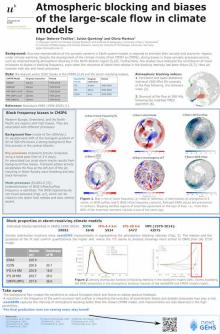Atmospheric blocking and biases of the large-scale flow in climate models
Edgar
Dolores Tesillos
Institute of Geography, Oeschger Centre for Climate Change Research, University of Bern, Bern, Switzerland
Poster
Synoptic features, such as atmospheric blocking, extratropical cyclones, and Rossby wave packets, modulate the mid-latitude weather and climate. However, several studies have shown strong biases in these synoptic processes in climate models, such as underestimating atmospheric blocking in the North Atlantic region. Moreover, few studies have analyzed the contribution of moist processes to biases in blocking frequency; here, we consider both dry and moist processes.
We evaluate the large-scale flow representation in 4 CMIP6 models, taking the ERA5 reanalysis as a reference. A framework is presented to link biases at different synoptic scales, from atmospheric blockings to eddy transient activity. For the first time, we analyzed the warm conveyor belt (WCB) outflow representation in the CMIP6 models.
CMIP6 models underestimate the atmospheric blocking frequency in the North Atlantic in winter (December to February) and result from combined biases in different processes described in the following. First, we found that misrepresenting the background flow plays a primary role.
We define the background flow as the most frequent value of the latitudinal gradient of the geopotential at 500 hPa.
Stronger geopotential gradients in the North Atlantic are identified in the CMIP6 models, which can drive stronger winds at middle levels, reducing the environment for Rossby wave breakings. The latter is proven by computing the Rossby wave-breaking overturnings. The CMIP6 models show a negative bias in overturning frequency in the North Atlantic region.
Moreover, a negative bias in WCB outflow in the North Atlantic indicates less transport of low PV from lower to upper levels, reducing the downstream ridge amplification. The WCB outflow reduction can be associated with less latent heating release upstream from cloud formation.
Furthermore, an equatorward shift in transient eddy activity contributes to reducing the frequency of winter atmospheric blocking in the North Atlantic.
Finally, we introduce some results from the new generation of storm-resolving climate models (NextGEMS) and provide hints about how the large-scale flow can benefit from the storm-resolving models at the atmospheric-blocking scale. The NextGEMS ICON and IFS models show improvements at the event scale; specifically, the IFS at 4.4 km captures persistence and intensity better than coarser resolution models. A caveat is that only short runs (~ 5 years) are available, which results in biases in the geographical distribution, but this can be associated with climate variability.
Thus, we show the relevance of considering diabatic processes and the need for more extended storm-resolving model runs.
We evaluate the large-scale flow representation in 4 CMIP6 models, taking the ERA5 reanalysis as a reference. A framework is presented to link biases at different synoptic scales, from atmospheric blockings to eddy transient activity. For the first time, we analyzed the warm conveyor belt (WCB) outflow representation in the CMIP6 models.
CMIP6 models underestimate the atmospheric blocking frequency in the North Atlantic in winter (December to February) and result from combined biases in different processes described in the following. First, we found that misrepresenting the background flow plays a primary role.
We define the background flow as the most frequent value of the latitudinal gradient of the geopotential at 500 hPa.
Stronger geopotential gradients in the North Atlantic are identified in the CMIP6 models, which can drive stronger winds at middle levels, reducing the environment for Rossby wave breakings. The latter is proven by computing the Rossby wave-breaking overturnings. The CMIP6 models show a negative bias in overturning frequency in the North Atlantic region.
Moreover, a negative bias in WCB outflow in the North Atlantic indicates less transport of low PV from lower to upper levels, reducing the downstream ridge amplification. The WCB outflow reduction can be associated with less latent heating release upstream from cloud formation.
Furthermore, an equatorward shift in transient eddy activity contributes to reducing the frequency of winter atmospheric blocking in the North Atlantic.
Finally, we introduce some results from the new generation of storm-resolving climate models (NextGEMS) and provide hints about how the large-scale flow can benefit from the storm-resolving models at the atmospheric-blocking scale. The NextGEMS ICON and IFS models show improvements at the event scale; specifically, the IFS at 4.4 km captures persistence and intensity better than coarser resolution models. A caveat is that only short runs (~ 5 years) are available, which results in biases in the geographical distribution, but this can be associated with climate variability.
Thus, we show the relevance of considering diabatic processes and the need for more extended storm-resolving model runs.

Poster file
Meeting homepage
